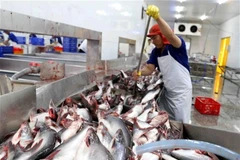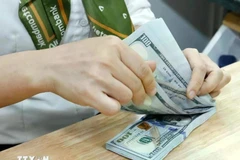Hanoi (VNS/VNA) - Vietnam's shrimp industry expects to increase exportsthis year end because of a rise in demand, according to the Vietnam AssociationSeafood Exporters and Producers (VASEP).
Prices are also expected to be higher from the beginning of the third quarterof 2020 because of lower shrimp inventories in major markets such as Japan, theUS and the EU than in previous months.
Shrimp supply in China is forecast to decrease due to the impact of shrimpdisease. Lockdown in India which lasted until May has affected production,leading to unstable supplies. The pandemic has also affected the raw shrimpsupply of Ecuador, Indonesia and Thailand, the association said, so the exportsthere have reduced by 30 percent each country.
This is an opportunity for Vietnam to promote its shrimp exports, it said.Farmers are still actively producing raw shrimp to meet enterprises’ demand onmaterial for shrimp export processing.
In addition, businesses have also enjoyed government support packages to helpthem to overcome difficulties caused by the pandemic and take advantages ofopening market according to commitments of free trade agreement, especiallyEVFTA and CPTPP.
Shrimp exported to the EU would enjoy preferential tax breaks according to the Vietnam-EUFree Trade Agreement (EVFTA).
The tariffs of most raw shrimp, including fresh, frozen and chilled productsexported from Vietnam into the EU would be gradually reduced from the basicrate of 12-20 percent to zero after the agreement comes into effect in Augustthis year. Meanwhile, import tariffs of processed shrimp will fall to zeroafter seven years.
With those advantages, VASEP expects shrimp export this year is likely to reach3.8 billion USD, 300 million USD higher than its previous forecast.
The Government needs to quickly implement supportive measures, especiallycredits for shrimp breeding farmers, VASEP Secretary General Truong Dinh Hoe said.
It should also reduce loan interest rates, taxes and land rents and extendingpayment of them to help businesses restore production, he said.
However, according to VASEP, Vietnam's shrimp exports are still facing manychallenges in domestic and global markets. Local businesses need to focus onbuilding links from raw material production to processing for managing foodsafety and hygiene and improving the competitiveness of products.
Ho Quoc Luc, chairman of the Directorate Board of Fimex Vietnam, said theenterprises must ensure quality and strictly comply with all terms of thesigned contracts such as delivery time and packaging design.
They also need to improve financial ability and production scale, and enhancetrade promotion programmes to attract more customers, he said.
Meanwhile, local authorities must have many projects calling for investment inbuilding shrimp farms with international quality standards. They also need tomake investment in infrastructures such as electricity, irrigation and trafficroads, creating good conditions for high-quality shrimp production, he said.
According to VASEP, Vietnam's shrimp export value in the first five months ofthis year reached 1.2 billion USD, up slightly by 2.3 percent over the sameperiod last year.
Of which, white leg shrimp and tiger prawn accounted for 69.5 percent and 19.2 percentof the total value, respectively. The high export value of white-leg shrimpduring the pandemic was due to reasonable price, VASEP said.
In the first five months, the key export market for Vietnamese shrimp productsincluded Japan, the EU, the Republic of Korea, China and the US. Of which, theshrimp exports to Japan, EU, and the RoK had the slowest growth and evenreduced. Exports to the US, China and the UK recorded high growth and isexpected to maintain the growth by this year end.
Shrimp exports to the US recorded a high growth of 29.5 percent in May to 65.8million USD compared to May 2019. In the first five months, it reached 224.5million USD, up 20.4 percent year on year.
Exports to Japan rose by 3.2 percent to 225.6 million USD.
Meanwhile, it declined by 7 percent to 162 million USD to the EU and 9.6 percentto 169 million USD to China in the first five months./.






























